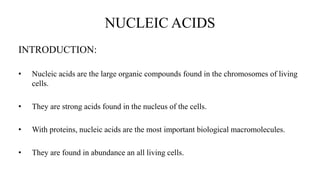
Essential Biopolymers: DNA and RNA
- 1. NUCLEIC ACIDS INTRODUCTION: • Nucleic acids are the large organic compounds found in the chromosomes of living cells. • They are strong acids found in the nucleus of the cells. • With proteins, nucleic acids are the most important biological macromolecules. • They are found in abundance an all living cells.
- 2. History: 1. In 1869, Friedrich Miescher isolated nuclei from pus cell and found that they contained phosphate-rich substance, he named it nuclein. 2. Fischer in the 1800s, discovered purine and pyramidine bases in nuclein. 3. Zacharis in the year 1881, identified nuclein with chromatin. 4. In 1884, Hertwig claimed that nuclein is responsible for the transmission of hereditary characters.
- 3. 5. In 1899, Altmann, introduced the term nucleic acid. 6. In 1941, Caspersson and Brachet, related that nucleic acids were connected to protein synthesis. 7. In 1994, Oswald T. Avery, Colin M. Macleod and Maclyn McCarty, experimented that DNA is directly invovled in inheritance. 8. In 1953, James D. Watson ans Francis H.C. Crick constructed the double helical model for the DNA molecule.
- 5. NUCLEIC ACIDS • Nucleic acids are biopolymers, or large biomolecules, essential for all known forms of life. Nucleic acids, which include DNA (deoxyribonucleic acid) and RNA (ribonucleic acid), are made from monomers known as nucleotides. Each nucleotide has three components: a 5-carbon sugar a phosphate group, and a nitrogenous base. • It has two types DNA, (deoxyribonucleic acid) RNA (ribonucleic acid),
- 6. FUNCTIONS OF DNA 1. Replication 2. Encoding information 3. Mutation and recombination 4. Gene expression
- 7. REPLICATION. • DNA exists in a double-helical arrangement. • Each base along one strand binds to a complementary base on the other strand. • Bacteria and mitochondria may also have single-strand DNA arranged in a ring. • When a cell divides, the chromosomes containing the DNA strands must replicate. • The enzyme DNA polymerase assists in the process.
- 8. ENCODING INFORMATION. • The base sequences of A, T, C and G along a DNA strand are organized into units called genes. • An adjacent trio of bases, called a codon, specifies a particular amino acid. • Sequence of bases in genes determines the sequence of amino acids in proteins. • protein are the biochemical units of a cell’s structure and function
- 9. MUTATION AND RECOMBINATION • DNA plays a role in the evolution of a species. • Mutations can be changes in just one DNA base. • Mutations can involve entire segments of chromosomes. • The new sequences might produce new proteins, some of which are beneficial to the organism • Natural selection of beneficial traits can produce changes that make an organism more fit for survival and reproduction. • DNA can also repair itself through recombination
- 10. GENE EXPRESSION • Each cell contains a full complement of genes, yet cells from different tissues and organs look and behave different. • DNA plays a role as a traffic cop for the types of proteins a cell will make. • It does this through interactions with proteins in the cells that cause only certain genes to express themselves. • The DNA can respond to the need for a particular protein by exposing the appropriate genes for transcription while keeping other genes inactive.
- 12. FUNCTIONS • Nucleic acids are the genetic material for all living cells. • The main functions of nucleic acid is to store and transfer genetic information. • To use genetic information to direct the synthesis of new protein. • Nucleic acids determine the phenotype of an organism. • The deoxyribonucleic acid is the storage for place for genetic information in the cell. • DNA controls the synthesis of RNA in the cell. • The genetic information in transmitted from DNA to the synthesis in the cell.
- 13. FUNCTIONS • RNA also directs the production of new protein by transmitting genetic information to the protein building structures. • The functions of the nitrogenous base sequences in the DNA backbone determines the proteins being synthesized. • The functions of the double helix of the DNA is that no disorders occur in the genetic information if it is lost or damaged. • RNA directs the synthesis of transcription. • m-RNA takes genetic message form RNA. • t-RNA transfers activated amino acid to the site of protein synthesis. • t-RNA are mostly present in the ribosomes and responsible of stability of m-RNA.
- 16. PROPERTIES • Nucleic acids (DNA and RNA) are long polymers made of repeating units of molecules. • Nucleotide units are made of phosphate, sugar and nitrogenous bases. • The nitrogenous bases found in DNA are adenine guanine thymine and cytosine. • Adenine and guanine are purine bases while cytosine and thymine are pyrimidines.
- 17. PROPERTIES • In RNA, the thymine bases replaced by uracil. • The double. stranded model of the DNA was worked out by Watson and Crick model in 1953. • The double helix model consists of two strands wound around a central axis with the bases stacked inside. • The order of the strand is in opposite direction i.e. from 5 to 3 direction in one and from 3 to 5 direction in the other. • The bases are stacked in the center of the helix as they interact with each other through weak hydrogen bonds. • Hydrogen bonds are weaker than covalent bonds they are continually forming and disassociating.